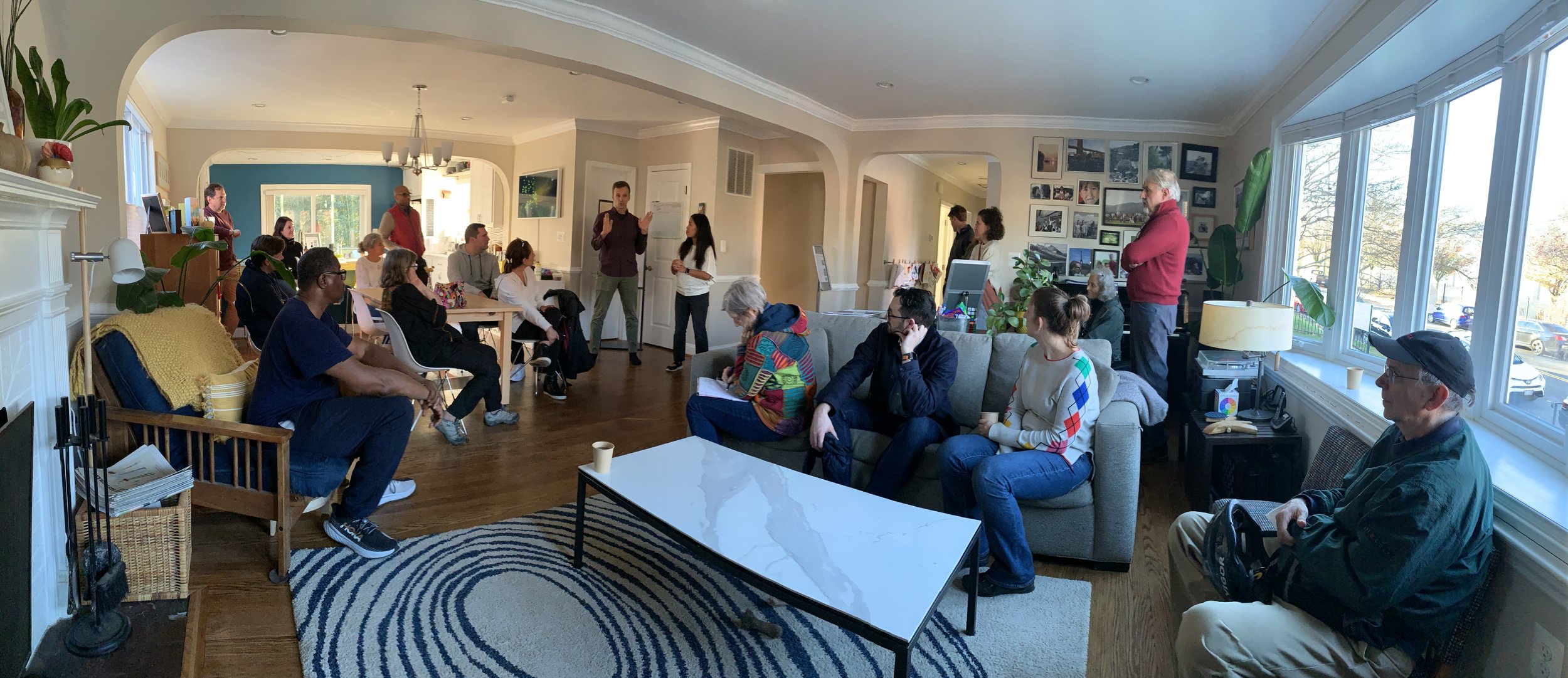Kim and Charlie’s Net-Zero Journey: Electrifying a Washington DC Home
On a Saturday afternoon in November, more than 35 people gathered in a home in Upper Brightwood to experience the future of sustainable living. Electrify DC’s first Demonstration Site Open House, in collaboration with the District Department of Buildings and the District Department of Energy and Environment, is an innovative way to meet residents where they are (literally) and answer their questions on home decarbonization. Demonstration Sites are a critical element of Electrify DC’s ecosystem of programs to make it easier, faster and more affordable to decarbonize all homes.
Excited chatter filled the room as neighbors, real estate agents, and curious homeowners and renters toured a fully electrified, net-zero house, marveling at its practical and accessible features complete with affordable renewable energy technologies. Conversations flowed, with visitors exchanging ideas and posing thoughtful questions about the realities of electrification:
–How can solar panels power an entire home?
–What are the costs of transitioning to heat pumps and induction stoves?
–Can this model work for every DC neighborhood?
–What incentives are available?
Net-Zero homeowners answer questions before touring their fully electrified home in Washington DC.
The open house was more than just a tour – it was a gathering united by the shared vision of healthier, more comfortable homes and a greener, more resilient future for the District.
Starting the Journey: Setting Goals
Kim and Charlie moved to Washington, DC in 2011 after getting married. Together with their two sons and their dog, they’ve created a home that reflects their commitment to sustainability. Living in the Upper Brightwood neighborhood, they’ve transformed their 1950s ranch-style house into an energy-efficient and fully electrified residence.
For Kim and Charlie, the path to sustainability started with clear communication, planning, and education:
Shared Goals: Sustainability was a shared family priority. Their approach involved aligning goals and including their children in the process.
Budgeting and Prioritizing: They assessed what they could afford immediately, what needed financing, and what would have to wait.
Creating a Flexible Timeline: To manage costs and tax incentives, they spread projects over several years.
Learning and Research: Partnering with Electrify DC and learning from others’ experiences was key.
Energy Audit: A professional audit helped identify areas for improvement and prioritize projects.
Here’s the Math: Project by Project
Kim and Charlie tackled a series of projects to reach their electrification goals. Here are some highlights:
1. Solar Panels
Installed in 2022, their 40-panel array (16.2kW) generates more electricity than they use annually, making their home net-positive.
Net Cost: $33,645 (after tax credits).
Production: In the first year, they generated 5,705 kWh more than they consumed! They estimate that even now that all of their appliances are electric they will still generate more than they use.
2. Attic Insulation
Addressing air leaks and boosting attic insulation improved efficiency and comfort.
Cost: $2,235 (post-incentives).
Result: A measurable increase in energy efficiency, reducing air leakage significantly.
3. Crawlspace Encapsulation
Transforming their crawlspace into a conditioned storage area eliminated cold floors and enhanced energy efficiency.
Result: A 26% reduction in air leakage, making the space more functional.
4. Electrical Upgrades + Induction Cooking
Switching from gas to an induction range modernized their kitchen and eliminated gas utility bills. You read that right: No Gas Bills!
Cost: $1,740 for electrical work and $2,120 for the range.
Benefits: Faster cooking and savings on utility bills.
5. Heat Pump Installation
Replacing their gas furnace with a heat pump ensured year-round comfort with exceptional energy efficiency.
Cost: $14,650 (after tax credits).
Result: Quiet operation and full capacity even in extreme cold (-13°F).
What’s Next?
Kim and Charlie are committed to continuous improvement. Their plans include:
Heat Pump Water Heater: Transitioning from a regular electric water heater to a more efficient electric water heater that uses heat pump technology.
Electric Car Charging: Exploring safe installation options for a Level 2 charging station on the street, as they do not own a garage.
Battery Storage: Investing in backup power solution sto store the excess energy produced by their solar panels.
Further Weatherization: Enhancing insulation of the existing addition to their home.
Building Community and Sharing Knowledge
Kim and Charlie’s journey doesn’t stop at their doorstep. By sharing their experience, they hope to inspire others to take steps toward sustainability. Their home serves as a model for how DC residents can electrify their homes and reduce their carbon footprint.
Join the Journey
Explore more about sustainable home electrification on ElectrifyDC.org. Let Kim and Charlie’s story spark your path toward a greener future!
SEE THE LATEST IN RENEWABLE ENERGY TECHNOLOGY AT THE 2025 HEALTHY HOMES FAIR.

